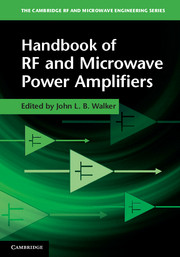Book contents
- Frontmatter
- Contents
- Contributors
- Preface
- 1 Silicon LDMOS and VDMOS transistors
- 2 GaAs FETs – physics, design, and models
- 3 Wide band gap transistors – SiC and GaN – physics, design and models
- 4 Amplifier classes, A to S
- 5 Computer-aided design of power amplifiers
- 6 Practical HF/VHF/UHF RF power amplifier realization
- 7 Microwave hybrid amplifier realization
- 8 Monolithic power amplifiers
- 9 RF power amplifier thermal design
- 10 Reliability
- 11 Power amplifier applications
- 12 Amplifier measurements
- About the authors
- Index
- References
4 - Amplifier classes, A to S
Published online by Cambridge University Press: 05 November 2011
- Frontmatter
- Contents
- Contributors
- Preface
- 1 Silicon LDMOS and VDMOS transistors
- 2 GaAs FETs – physics, design, and models
- 3 Wide band gap transistors – SiC and GaN – physics, design and models
- 4 Amplifier classes, A to S
- 5 Computer-aided design of power amplifiers
- 6 Practical HF/VHF/UHF RF power amplifier realization
- 7 Microwave hybrid amplifier realization
- 8 Monolithic power amplifiers
- 9 RF power amplifier thermal design
- 10 Reliability
- 11 Power amplifier applications
- 12 Amplifier measurements
- About the authors
- Index
- References
Summary
Introduction
The alphabetical classification of electronic amplifiers appears to date back to the earliest era of electronics, and as such could well be approaching the centenary mark. Its survival to the present day represents a remarkable continuity, given the vast changes in technology that have taken place in the intervening decades. It can also represent a distraction for the modern RFPA designer working with solid state active devices and GHz frequencies, both of which were well below the horizon when the original classification came into general use. The plan in this chapter is to introduce and define the various Classes,1 and then consider how the original intent is often modified in typical modern applications, sometimes to the point where the original concept migrates into something palpably different.
Although the definitions of Class A, AB, B, and C are well established and have a long historical precedent, the subsequent Classes (D, E, F, etc.) are of much more recent origin and in some cases have suffered from different interpretations by different authors. A curious but endemic feature of this subject is the assertive use of classifications by authors and designers when the final amplifier current and voltage waveforms have not been (and in many cases cannot easily be) measured directly. This has been known to lead to considerable controversy, given that some amplifier “Classes” have even been patented. Another issue which comes up when addressing this subject with a modern perspective is the intrusion of digital approaches to power amplification, primarily in the form of so-called “switch modes.” As active device technology improves, the frequency range at which it can be made to behave as a near-ideal switch increases. Until recently, this range could be reasonably restricted to the “HF” (MHz to tens of MHz) region, but newer technologies such as gallium arsenide and gallium nitride have extended this region into the “VHF” (hundreds of MHz), and more arguably into the “microwave” (GHz) region. There is thus something of a “gray” area, where a particular amplifier can be considered as a “smoothed-out” switch mode, or alternatively as a more conventional analogue PA class with some extra harmonic components. Both of these approaches will be described in the later sections on Class S, E, and J amplifier.
- Type
- Chapter
- Information
- Handbook of RF and Microwave Power Amplifiers , pp. 159 - 187Publisher: Cambridge University PressPrint publication year: 2011
References
- 2
- Cited by

